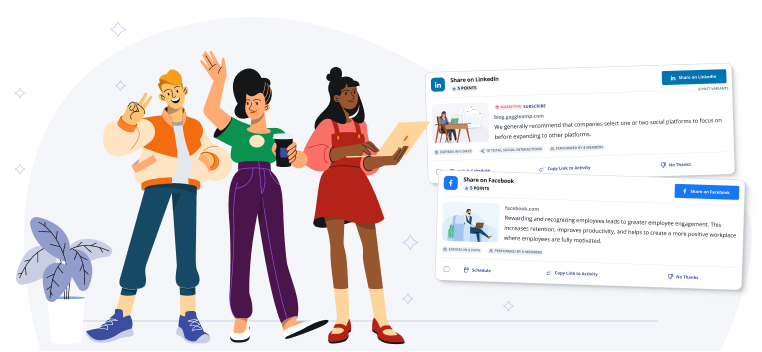Employee engagement isn’t just about satisfaction surveys and annual offsites—it’s a measurable driver of productivity, retention, and brand advocacy. When employees are engaged, they become advocates for your mission and amplify your company’s presence both internally and externally.
According to Gallup, only 32% of U.S. employees are engaged in their work—meaning nearly 7 in 10 are not engaged, marking a 10-year low in employee engagement. That’s a huge opportunity gap. Disengaged employees cost companies money, hurt culture, and contribute to high turnover. Meanwhile, engaged employees are more likely to share company content on LinkedIn, speak positively about leadership, and stay long-term.
If your leadership is pushing for stronger brand awareness, increased reach on social platforms, or better recruiting outcomes, engagement programs are your engine.
Core Pillars of a Successful Employee Engagement Program
Building an effective program means thinking beyond ping pong tables and free snacks. A strong engagement strategy is grounded in four essential pillars that together foster a culture of communication, alignment, and enthusiasm for company goals:
-
Leadership Buy-In: Engagement starts at the top. If your executives don’t model the behavior you want to see, neither will your employees. Leadership should actively participate in initiatives, reinforce the importance of engagement, and publicly recognize employee contributions. This creates a ripple effect, signaling that engagement is a business priority—not an HR side project.
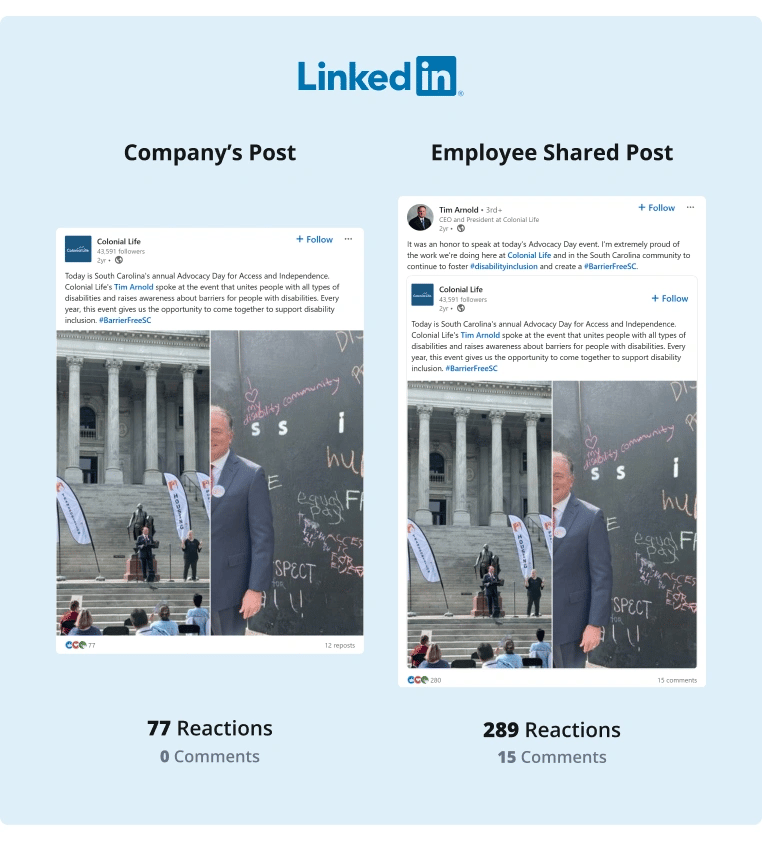
-
Employee Feedback Loop: You can’t engage people without understanding them. Use pulse surveys, 1:1s, and town halls to gather feedback frequently. Create structured forums where employees can share ideas, voice concerns, and suggest improvements. Then act on what you hear. When employees see their input reflected in changes, it deepens their sense of ownership.
-
Integrated Tools: Employees won’t engage if it means navigating clunky software or switching platforms. Integrate your engagement tools into systems they already use—Slack, Teams, HubSpot, etc. The more embedded the experience, the more seamless participation becomes.
-
Clear Goals & Metrics: Your engagement program should align with broader business outcomes. Are you trying to increase social shares, reduce turnover, or attract more job applicants? Set specific, measurable goals and define what success looks like and how it ties back to departmental KPIs so that Marketing, Sales, and HR can work together toward shared outcomes.
Here’s what happens when employee engagement fuels advocacy: measurable social growth. Just ask SendGrid—who saw massive gains after aligning their internal efforts with a structured sharing strategy.

Once the foundational pillars are in place, you’re ready to bring your engagement strategy to life. The next step? Choose the right programs that align with your culture, goals, and resources. Let’s look at six high-impact employee engagement initiatives that companies are using right now to drive connection, motivation, and results.
6 Employee Engagement Programs That Actually Work
Employee engagement doesn’t happen by accident. It requires intentional, ongoing programs that build trust, motivation, company culture, and a sense of community. Here are six proven initiatives that help build a high-performing, connected workforce:
1. Employee Recognition & Rewards Programs
Employees want to feel seen—not just for hitting KPIs, but for their consistent effort, collaboration, and innovation. Recognition programs make that visibility intentional. Whether it’s a formal performance award, a quarterly shout-out, or a point-based incentive system, these programs validate the value employees bring every day.
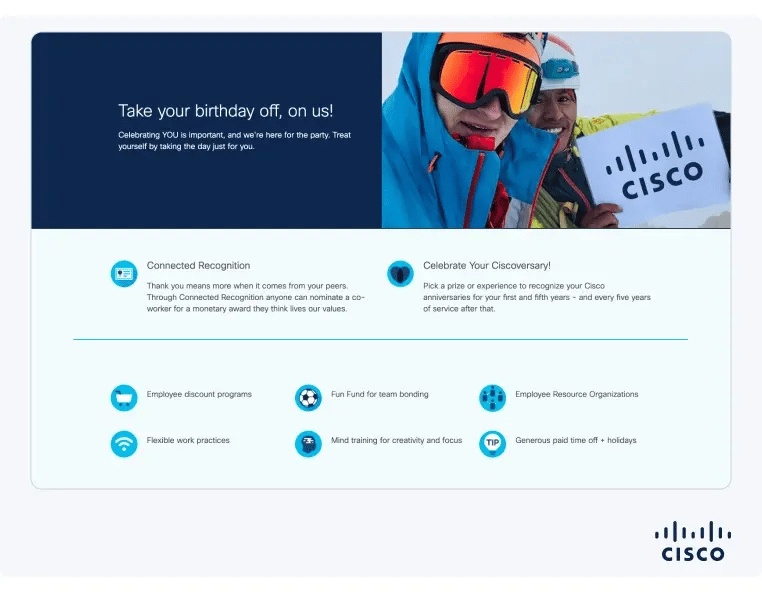
A standout example is Cisco’s “Connected Recognition” program. Designed as a global initiative to embed recognition into the company culture, it allowed leaders to acknowledge employee contributions in real time. The program was funded at 1% of payroll, signaling its importance as a strategic business investment—not just an HR initiative. By systematizing appreciation and tying it to company values, Cisco creates a culture where effort is noticed, performance is celebrated, and employees feel motivated to stay and grow.
2. Career Development & Professional Growth
People crave progress. When companies provide skills training, mentorship, and clear career paths, employees feel invested in—and stay longer. Adobe is a strong example of this philosophy in action. Instead of annual performance reviews, they implemented the Check-In system, a continuous feedback model that encourages regular goal-setting, growth conversations, and real-time coaching between managers and employees.
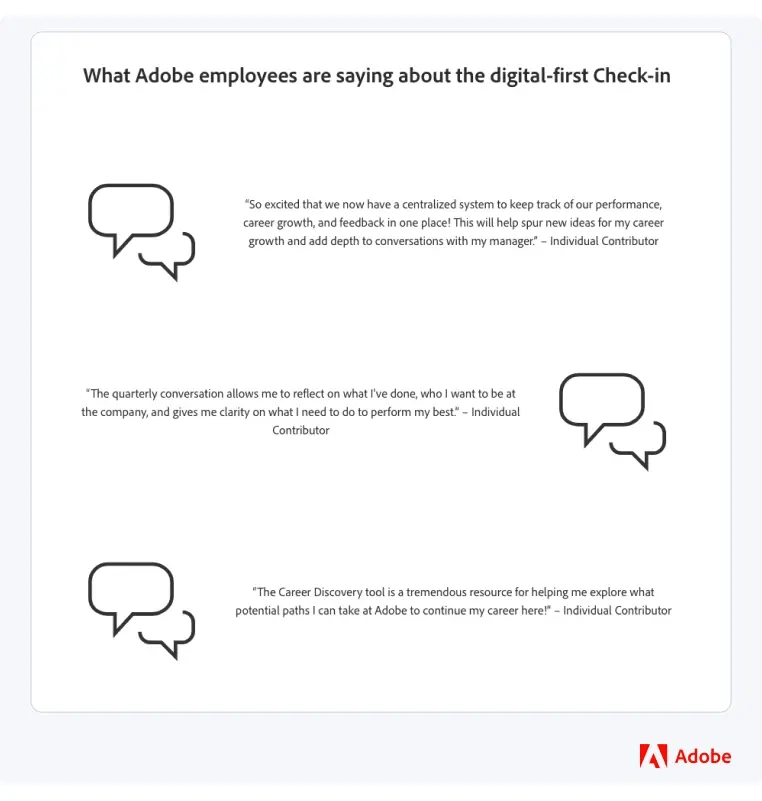
The goal? Create a culture where development is always-on, not once a year. This shift has helped Adobe nurture internal talent, reduce friction around promotions, and foster a stronger sense of purpose and engagement across teams.
3. Social Media Advocacy Programs
When employees become advocates online, they do more than boost impressions—they make your brand feel human, relatable, and trustworthy. People trust people more than logos, and when your team shows up authentically on platforms like LinkedIn or X (formerly Twitter), it signals a healthy internal culture that people want to work with—or work for.
But getting employees to consistently share company content isn’t easy, especially when they’re already overwhelmed with their day-to-day work. Advocacy platforms like GaggleAMP make it easy for employees to share pre-approved content on LinkedIn or Twitter. With incentives and one-click actions, you empower even your busiest employees to participate in brand-building.
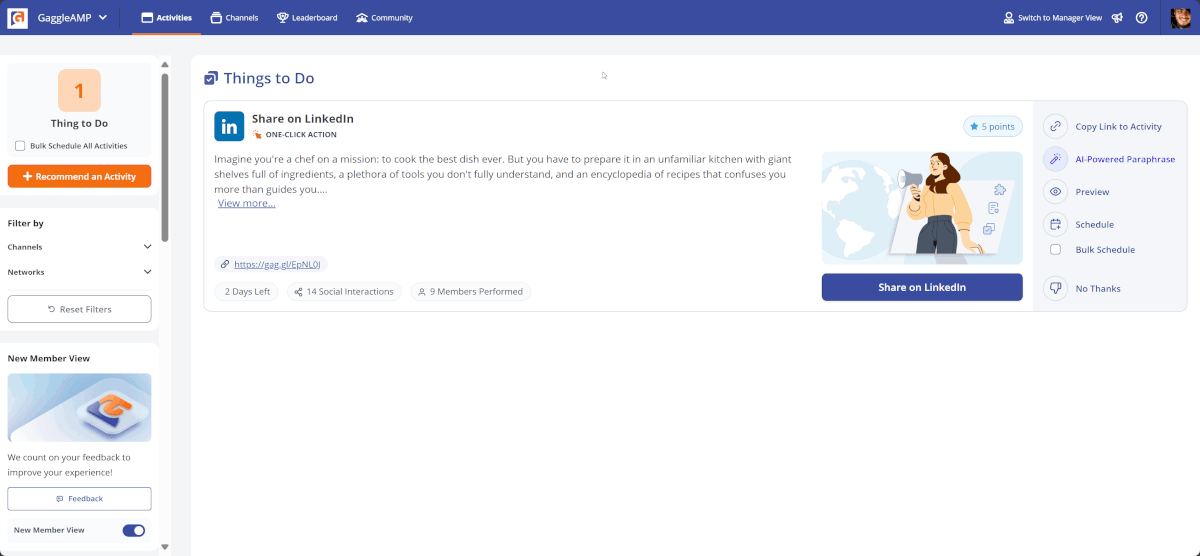
4. Wellness Initiatives
Work-life balance isn’t a buzzword—it’s a business strategy. Wellness programs can include mental health days, therapy stipends, fitness reimbursements, or team-wide "No Meeting" afternoons. These efforts demonstrate that your company cares about the whole person, not just their productivity.
For example, SAS Institute offers a comprehensive wellness program that includes on-site health care services, a recreation and fitness center, and a Work/Life Center providing resources for family and personal life balance. These initiatives have contributed to SAS's recognition as a top employer and have been associated with lower employee turnover rates compared to industry averages.

By investing in such wellness initiatives, companies not only enhance their employees' quality of life but also foster a more engaged and productive workforce.
5. Peer-to-Peer Recognition
Top-down praise is great—but peer recognition fosters something deeper: community, trust, and shared accountability. When employees are empowered to acknowledge each other’s efforts in real time, it creates a ripple effect of appreciation that can cut across departments, seniority levels, and even geographies.
Google extends its peer recognition culture even outside the company. Through its Open Source Peer Bonus Program, Googlers nominate contributors for exceptional work in open source projects. While the recipients are external, the philosophy is the same: when people go above and beyond, peers should have the power to recognize it. This kind of decentralized, values-aligned appreciation reinforces a culture where good work gets noticed—no matter where it happens.
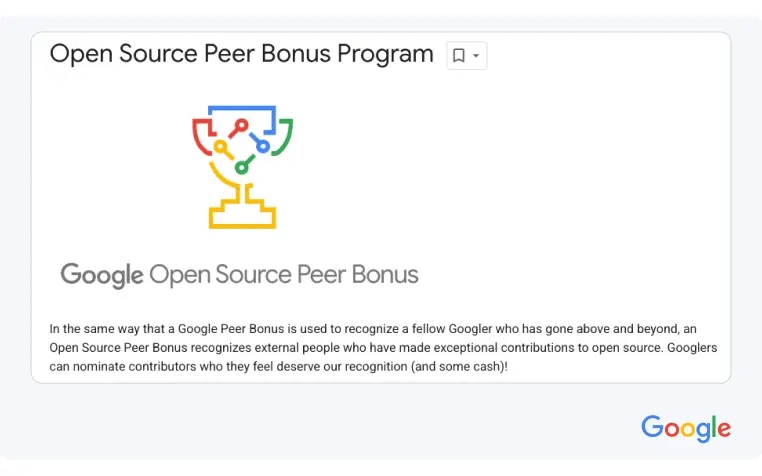
Programs like this don’t just improve morale—they democratize recognition, build camaraderie, and make your culture feel more human and inclusive.
6. Community Impact & Volunteering Days
Engaged employees often want to make a difference beyond office walls. Give them paid time to volunteer or participate in local causes. It builds camaraderie and reflects positively on your employer brand.
Salesforce is a standout example of embedding community impact into employee engagement. Through its Volunteer Time Off (VTO) program, employees receive up to seven paid days each year to volunteer for causes they care about. This approach empowers teams to give back in ways that align with their passions, while also strengthening team bonds and reinforcing a values-driven culture. In fact, Salesforce employees have logged millions of volunteer hours globally—making social impact a core part of the employee experience.
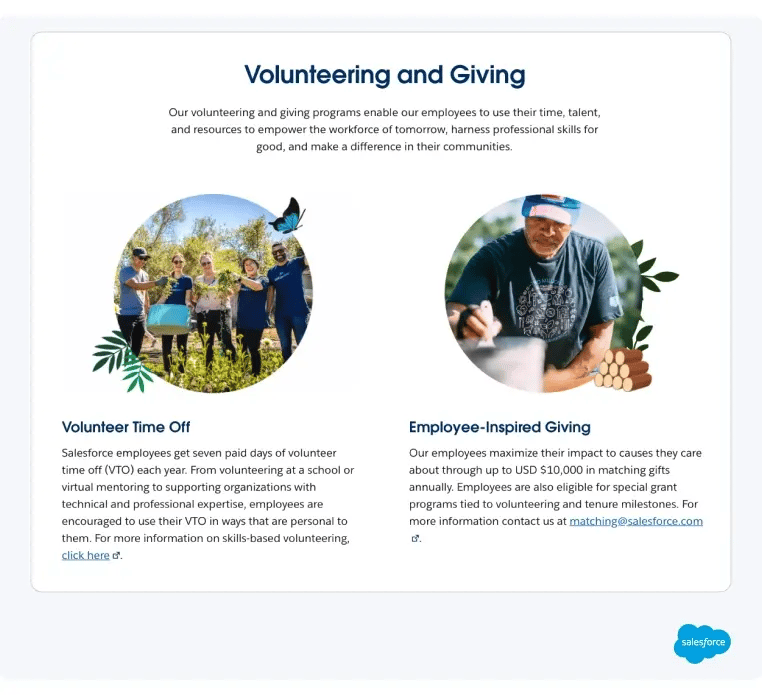
These examples highlight what’s possible, but no two engagement strategies are exactly alike. The key is designing a program that works for your team, your challenges, and your company’s stage of growth. Whether you're starting from scratch or refining an existing initiative, here’s a step-by-step approach to help you build an employee engagement program that actually sticks.
How to Develop an Effective Employee Engagement Program from Scratch
Whether you’re building from zero or refining an existing strategy, here’s a practical roadmap to improve employee engagement and increase adoption:
-
Audit Your Current State: Run an internal pulse survey, assess participation rates in current programs, and identify cultural gaps. Understand what’s working and what’s not—especially across departments and employee segments.
-
Involve Cross-Functional Teams Early: Bring HR, Marketing, Sales, and Operations into the planning process. Engagement is everyone’s responsibility, and programs only stick when multiple departments co-own the outcome.
-
Launch With Clear Messaging: Communicate the what, why, and how. Make participation simple and celebrate early wins. Use internal champions to drive momentum and create a feedback loop from day one.
-
Pick 1–2 High-Impact Initiatives: Don’t over-engineer the rollout. Choose initiatives that align closely with current pain points (e.g., low social engagement or high turnover). Focus on depth, not breadth.
-
Track Engagement & Iterate: Use tools like employee engagement surveys, participation dashboards, and engagement scoring to refine your program each quarter. Survey your employees not just on what they’re doing—but how they feel.
Colonial Life took this iterative approach—starting with a focused employee advocacy rollout and scaling to 500 engaged users. The result: stronger adoption, greater visibility, and a new mindset around brand engagement.
Engagement can be emotional, but it also needs to be measurable. Here’s what top companies track to evaluate success:
GaggleAMP isn’t just a tool—it’s a catalyst for engagement. For Marketing and HR leaders tasked with making advocacy scalable, it solves the biggest friction points:
True employee engagement doesn’t come from swag bags or quarterly surveys—it comes from a culture that listens, responds, and empowers. When done right, engagement turns employees into amplifiers of your brand, drivers of your culture, and champions of your mission.
If your employees aren’t proud to post about your company or participate in initiatives, that’s a sign—not a side effect.















